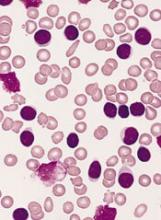LUGANO, SWITZERLAND—A sequential treatment regimen can produce a high overall response rate (ORR) in patients with treatment-naïve (TN) or relapsed/refractory (RR) chronic lymphocytic leukemia (CLL), results of the CLL2-BAG study suggest.
Patients who received bendamustine followed by obinutuzumab and venetoclax achieved an ORR of 95%, and 87% of them were negative for minimal residual disease (MRD) in the peripheral blood.
In addition, this regimen did not lead to cumulative or unexpected toxicity, according to study investigator Paula Cramer, MD, of University Hospital of Cologne in Germany.
Dr Cramer presented results from CLL2-BAG at the 14th International Conference on Malignant Lymphoma (ICML). The trial was sponsored by the German CLL Study Group.
CLL2-BAG included 63 patients—34 with TN and 29 with RR CLL. The median age was 58 (range, 43-76) and 61 (range, 28-77), respectively.
Thirty-five percent of TN patients had bulky disease (>5 cm), as did 45% of RR patients. Twelve percent and 10%, respectively, had massive splenomegaly (>20 cm)
Twenty-one percent of TN patients and 35% of RR patients were Binet stage A. Thirty-two percent and 21%, respectively, were stage B, and 47% and 45%, respectively, were stage C.
Treatment
Patients first underwent debulking with bendamustine, given at 70 mg/m2 on days 1 and 2 for two 28-day cycles. They then received induction with obinutuzumab and venetoclax for six 28-day cycles.
In cycle 1, patients received obinutuzumab at 100 mg or 900 mg on day 1 or 2 and 1000 mg on days 8 and 15. For cycles 2-6, patients received 1000 mg of obinutuzumab on day 1.
In cycle 2, patients received venetoclax at 20 mg on days 1-7, 50 mg on days 8-14, 100 mg on days 15-21, and 200 mg on days 22-28. For cycles 3-6, they received venetoclax at 400 mg on days 1-28.
Patients also received maintenance with obinutuzumab and venetoclax for 2 to 8 cycles with a duration of 84 days. Obinutuzumab was given at 1000 mg on day 1 of each cycle, and venetoclax was given at 400 mg on days 1-84.
Maintenance was continued until patients completed 24 months of maintenance therapy, until 3 months after patients achieved a complete response (CR) or CR with incomplete count recovery (CRi) and MRD negativity, until progression of CLL or start of new CLL treatment, or until unacceptable toxicity.
ORR, MRD, and survival
At the end of induction, the ORR was 95% in the entire population—100% among TN patients and 90% among RR patients.
The rate of CR was 8%, 9%, and 7%, respectively. The rate of unconfirmed/clinical CR/CRi was 32%, 41%, and 21%, respectively.
Five percent of patients progressed, all of them in the RR group.
Eighty-seven percent of evaluable patients were MRD negative (<10-4) in the peripheral blood, including 91% of TN patients and 83% of RR patients. Two patients (3%) were missing data on MRD status in peripheral blood.
Thirteen percent of all evaluable patients were MRD negative in the bone marrow, including 12% of TN patients and 14% of RR patients. The remaining patients (87%, 88%, and 86%, respectively) were missing data on MRD status in the bone marrow.
The progression-free survival at 15 months was 100% in the TN patients and 83% in the RR patients.
Adverse events
After debulking, 28.1% of TN patients and 46.7% of RR patients had experienced adverse events (AEs).
These included (in TN and RR patients, respectively) neutropenia (9.4% and 13.3%), anemia (6.3% and 20.0%), thrombocytopenia (6.3% and 6.7%), infections (6.3% and 6.7%), coronary artery disorders (1 TN patient, 3.1%), rash (1 TN patient, 3.1%), tumor lysis syndrome (1 TN patient, 3.1%), vomiting (1 TN patient, 3.1%), and pyrexia (1 RR patient, 6.7%).
After induction, 54.3% of TN patients and 80.6% of RR patients had experienced AEs.
These included (in TN and RR patients, respectively) neutropenia (34.3% and 54.8%), infections (8.6% and 29.0%), thrombocytopenia (2.9% and 22.6%), infusion-related reactions (5 RR patients, 16.1%), neoplasms (2.9% and 9.7%), hypertension (2.9% and 6.5%), coronary artery disorders (2.9% and 6.5%), anemia (3 RR patients, 9.7%), and tumor lysis syndrome (2 RR patients, 6.5%).


